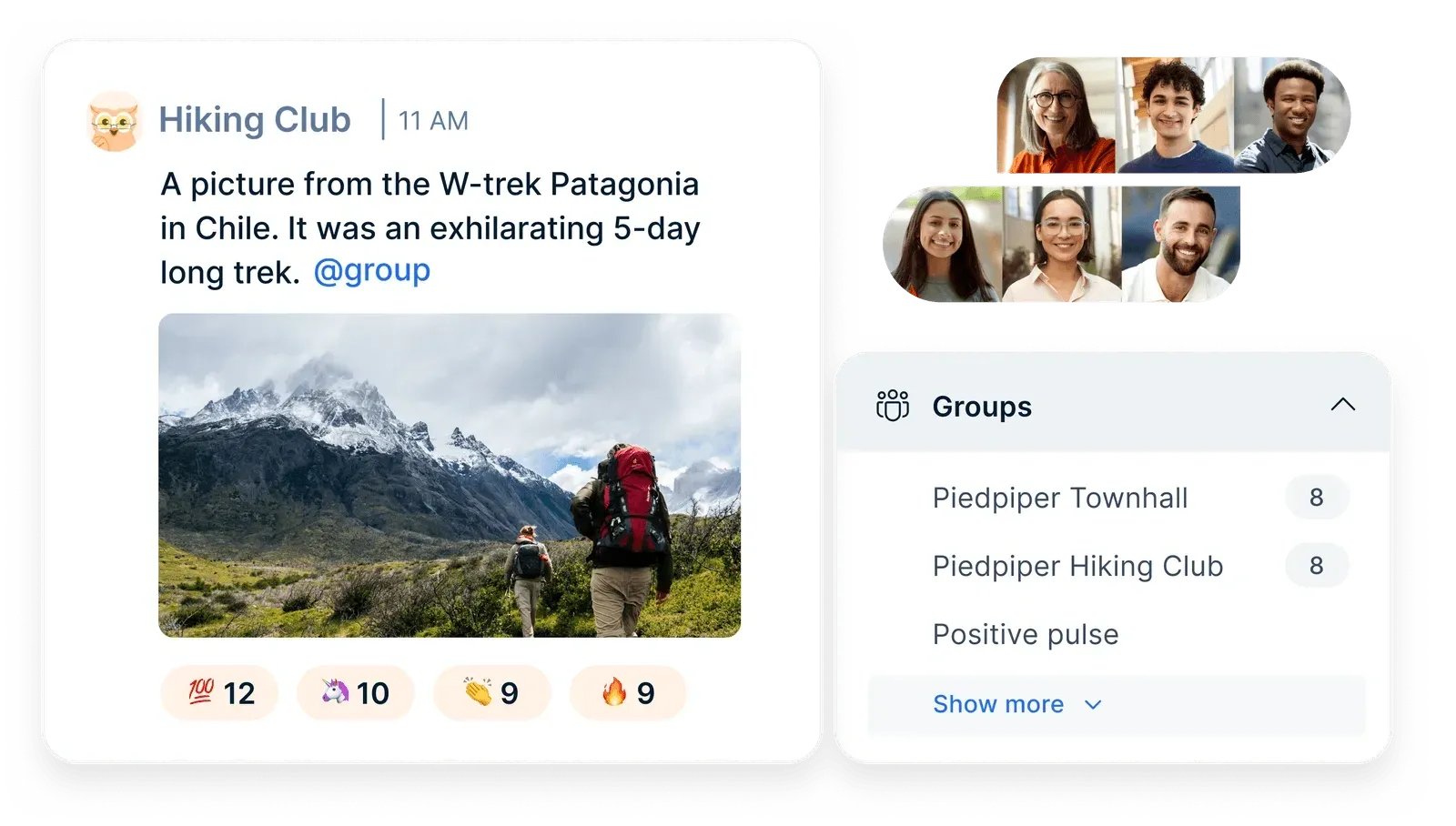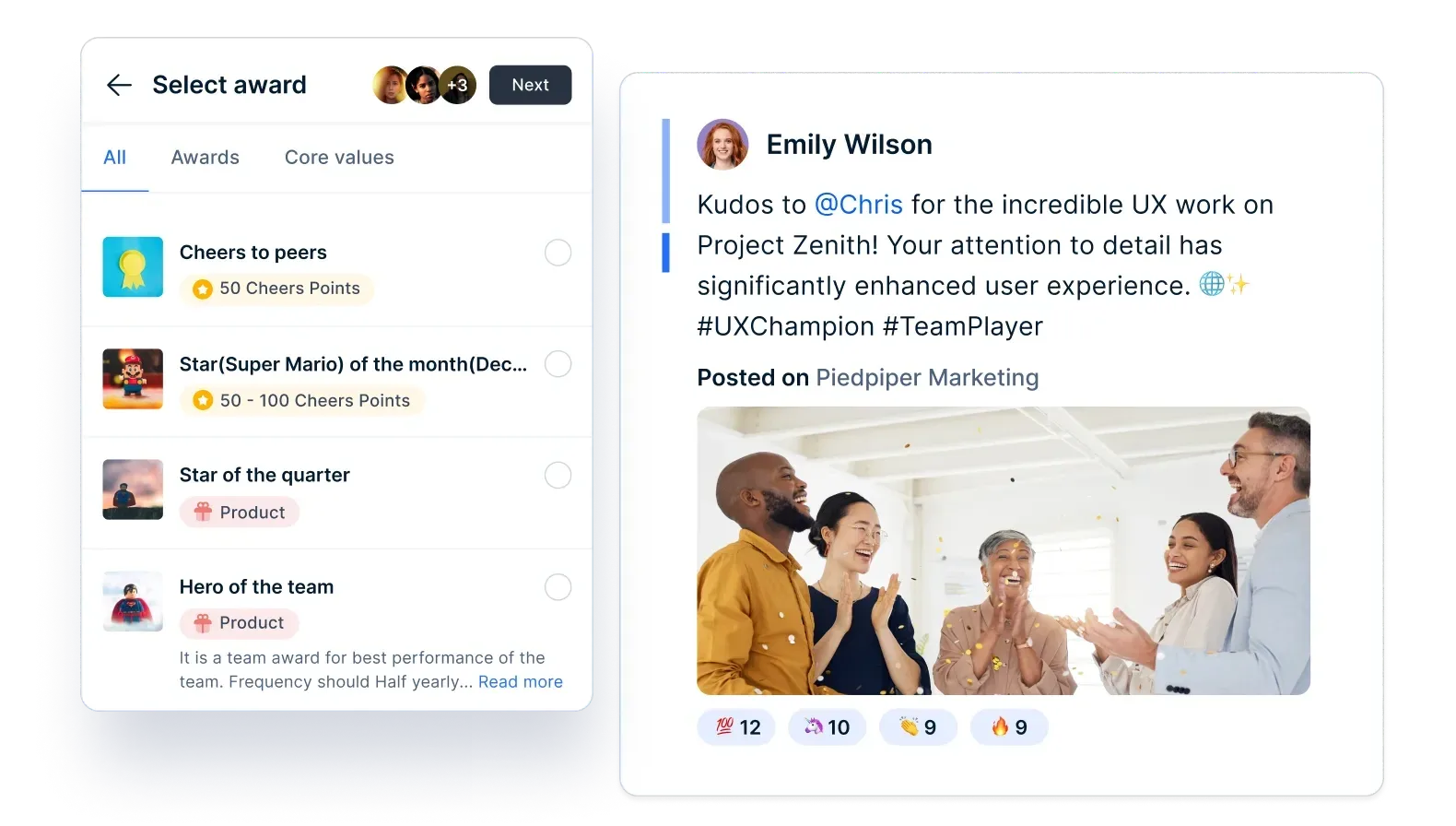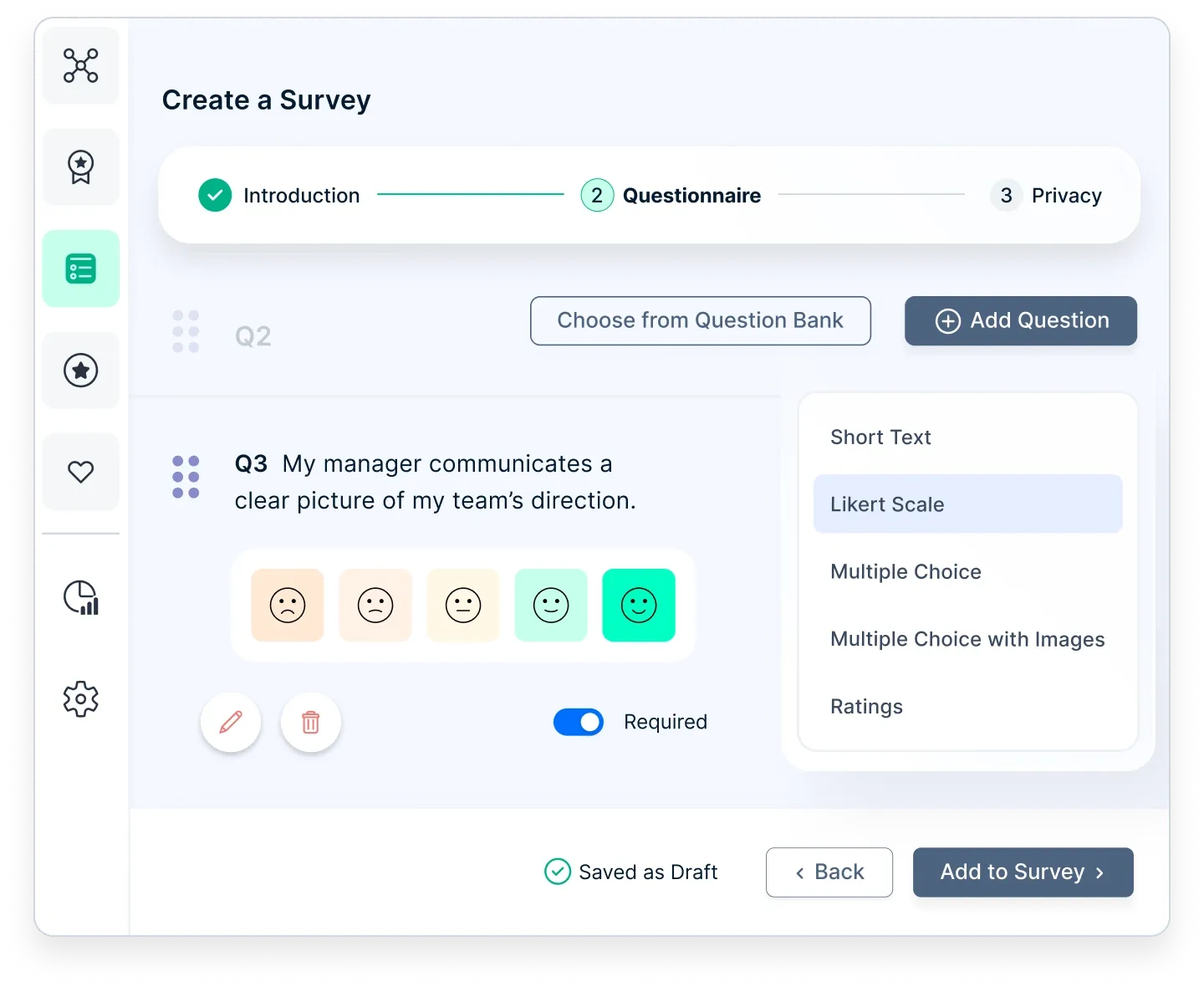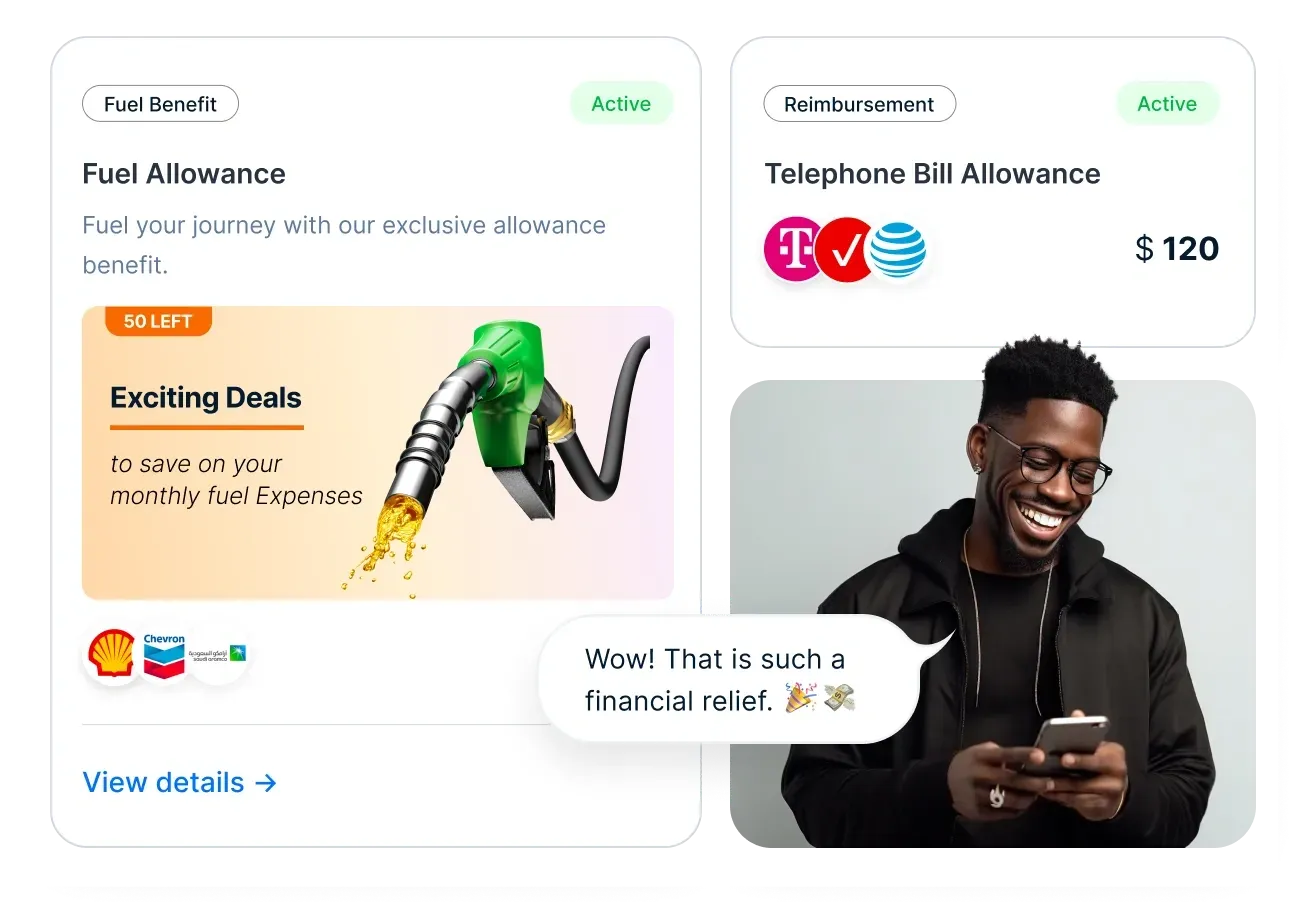65 Fun Employee Engagement Activities and Smart Initiatives for Your Team
Unlock your team's potential with these fun and creative employee engagement activities. Foster a positive work environment and boost morale.
On this page
- Benefits of employee engagement activities
- 15 Fun employee engagement activities
- 10 Employee engagement activities for team building
- 10 Fun ideas for employee engagement activities that support mental wellbeing
- 10 fun employee engagement activities for remote workers
- 10 fun employee engagement activities to aid in learning
- 10 Low-cost employee engagement activities
- How to implement employee engagement activities
- 6 Smart and effective employee engagement initiatives
- How to leverage Empuls for employee engagement activities
- Conclusion
Employee engagement refers to the emotional commitment and dedication that employees have towards their job, company, and its goals. It is important to a productive and successful workplace, as engaged employees are more motivated, productive, and satisfied with their jobs.
Employee engagement activities are the various initiatives and programs organisations implement to promote and enhance employee engagement in the workplace.
Employee engagement activities can take many forms, including team-building exercises, employee recognition programs, and workplace wellness programs, among others. These activities benefit employees and the company by increasing productivity, improving retention rates, and enhancing the company culture.
In this article, we will explore the various types of employee engagement activities, their benefits, and best practices for implementing them in the workplace.
Benefits of employee engagement activities
Employee engagement activities have numerous benefits for both employees and the organization. Companies can create a more positive and productive workplace culture by investing in employee engagement activities. Here are some of the key benefits of employee engagement activities:
- Improved employee morale and job satisfaction: Engaged employees are more satisfied with their jobs and feel more connected to their company and colleagues. This can result in increased job satisfaction and overall morale, positively impacting productivity.
- Higher productivity and efficiency: Engaged employees are more likely to be motivated and committed to their work, leading to higher productivity and efficiency. This can ultimately translate into better business results and a competitive advantage for the organisation.
- Better employee retention rates: Engaged employees are less likely to leave their jobs, reducing turnover and the associated costs of hiring and training new employees. This can also help to maintain a stable and experienced workforce, which can be crucial for long-term success.
- Enhanced company culture: Employee engagement activities can help to create a positive and inclusive company culture where employees feel valued and connected to their colleagues and the organisation's goals. This can lead to a more harmonious and collaborative workplace environment.
- Increased customer satisfaction: Engaged employees are more likely to provide high-quality customer service, increasing customer satisfaction and loyalty. This can ultimately lead to improved business results and a competitive advantage for the organisation.
15 Fun employee engagement activities
Here are the 15 fun employee engagement activities explained in detail:
1. Virtual game night
Organize a virtual game night where employees can participate in online games such as Classic Solitaire, pictionary, charades, or trivia. This activity promotes socialization and teamwork and helps employees bond with each other in a relaxed setting.
2. Employee recognition program
Start an employee recognition program where you acknowledge employees for their hard work and contributions. This activity boosts employee morale, motivates them to work harder, and enhances their loyalty to the company.
3. Happy hour
Host a virtual happy hour where employees can come together and socialize over drinks and snacks. This activity allows employees to unwind, relax, and socialize after work, which can reduce stress and improve their mental health.
4. Team building activities
Plan team building activities such as escape rooms, scavenger hunts, or outdoor activities like hiking or kayaking. These activities promote teamwork, communication, and problem-solving skills among employees.
5. Lunch and learn
Host a lunch and learn session where employees can bring their lunch and learn about a new topic. This activity promotes employee learning and development and helps them expand their knowledge base.
6. Book club
Start a book club where employees can read and discuss a book together. This activity promotes employee learning and development, encourages critical thinking, and enhances communication and collaboration skills.
7. Wellness programs
Offer wellness programs like yoga classes, meditation sessions, or fitness challenges. This activity promotes employee well-being, reduces stress, and promotes healthy lifestyles.
8. Employee volunteering
Organize employee volunteering events where employees can give back to the community. This activity promotes social responsibility, fosters teamwork, and enhances employee satisfaction.
9. Charity fundraising
Host a charity fundraising event where employees can raise money for a cause they care about. This activity promotes social responsibility, enhances employee morale, and fosters a sense of community among employees.
10. Office olympics
Plan an office olympics event with games like table tennis, foosball, or darts. This activity promotes friendly competition, encourages teamwork, and enhances employee engagement.
11. Coffee breaks
Host coffee breaks where employees can chat and relax while enjoying a cup of coffee or tea. This activity promotes employee bonding, reduces stress, and enhances workplace culture.
12. Brainstorming sessions
Conduct brainstorming sessions where employees can share ideas and collaborate on projects. This activity fosters creativity, encourages teamwork, and enhances employee engagement.
13. Employee feedback surveys
Send out employee feedback surveys to get their input on how to improve the workplace. This activity promotes employee engagement, enhances communication, and fosters a culture of continuous improvement.
14. Awards ceremony
Host an awards ceremony to recognize and celebrate the achievements of employees. This activity promotes employee morale, enhances recognition, and fosters a culture of appreciation.
15. Mentorship programs
Start a mentorship program where employees can learn from more experienced colleagues and grow their careers. This activity promotes employee learning and development, enhances communication and collaboration, and fosters a culture of continuous improvement.
10 Employee engagement activities for team building
Here are 10 employee engagement activities for team building:
16. Escape room challenge
Plan an escape room challenge where employees have to work together to solve puzzles and escape within a set time limit. This activity promotes teamwork, communication, and problem-solving skills.
17. Collaborative art projects
Organize collaborative art projects where employees work together to create a piece of artwork or mural. This activity promotes creativity, teamwork, and enhances workplace culture by creating a visual representation of their shared values.
18. Improv workshops
Conduct improv workshops where employees can learn to think on their feet and work together to create spontaneous stories and scenes. This activity promotes communication, creativity, and enhances teamwork.
19. Scrum methodology
Introduce the scrum methodology, which is a framework for agile project management. This activity promotes collaboration, communication, and enhances teamwork by providing a structured approach to project management.
20. Employee talent show
Host an employee talent show where employees can showcase their unique skills and talents. This activity promotes employee engagement, enhances workplace culture, and encourages employees to have fun and be themselves.
21. Office olympics
Plan an office olympics event with games like relay races, tug-of-war, or obstacle courses. This activity promotes friendly competition, teamwork, and enhances employee engagement.
22. Cross-functional training
Offer cross-functional training where employees can learn about different areas of the business and work together on projects. This activity promotes communication, collaboration, and enhances teamwork by breaking down silos and promoting cross-functional collaboration.
23. Team-building retreats
Plan team-building retreats where employees can go on a weekend trip or a day-long excursion. This activity promotes team-building, enhances communication, and helps employees bond with each other in a relaxed setting.
24. Personality assessments
Conduct personality assessments such as the myers-briggs type indicator (mbti) or disc assessments. This activity promotes self-awareness, enhances communication, and helps employees understand their strengths and weaknesses and how to work better with their colleagues.
25. Innovation labs
Host innovation labs where employees can brainstorm and come up with new ideas for products or services. This activity promotes creativity, encourages teamwork, and enhances employee engagement by giving employees the opportunity to contribute to the company's success.
10 Fun ideas for employee engagement activities that support mental wellbeing
Here are 10 fun ideas for employee engagement activities that support mental wellbeing:
26. Nature Walks
Organize nature walks during lunch breaks or after work. Being in nature can reduce stress, improve mood, and boost mental wellbeing.
27. Mindfulness sessions
Host mindfulness sessions where employees can learn techniques to manage stress and improve their mental wellbeing. This activity can promote mental clarity, reduce anxiety and depression, and enhance focus and productivity.
28. Laughter yoga
Conduct laughter yoga sessions where employees can learn to laugh and release tension in a group setting. This activity can improve mood, reduce stress, and enhance overall mental wellbeing.
29. Journaling workshops
Organize journaling workshops where employees can learn how to use writing as a tool for self-reflection and stress relief. This activity can promote emotional regulation, enhance self-awareness, and reduce anxiety and depression.
30. Guided meditation
Host guided meditation sessions where employees can learn to quiet their minds and relax. This activity can promote mental clarity, reduce stress and anxiety, and enhance overall mental wellbeing.
31. Gratitude practice
Encourage employees to practice gratitude by sharing something they are thankful for each day. This activity can promote positive thinking, reduce stress, and enhance overall mental wellbeing.
32. Music therapy
Conduct music therapy sessions where employees can listen to music and participate in group activities like singing or drumming. This activity can promote relaxation, reduce stress, and enhance overall mental wellbeing.
33. Color therapy
Offer color therapy sessions where employees can color mandalas or other designs to promote relaxation and reduce stress. This activity can enhance creativity, promote relaxation, and improve overall mental wellbeing.
34. Emotional intelligence training
Conduct emotional intelligence training where employees can learn to recognize and manage their emotions and improve their relationships with colleagues. This activity can promote self-awareness, enhance communication, and improve overall mental wellbeing.
35. Mental health first aid training
Offer mental health first aid training where employees can learn how to recognize and respond to mental health concerns. This activity can promote awareness, reduce stigma, and enhance overall mental wellbeing in the workplace.
10 fun employee engagement activities for remote workers
Here are 10 fun employee engagement activities for remote workers:
36. Virtual trivia night
Organize a virtual trivia night where employees can compete in teams and answer questions on various topics. This activity promotes teamwork, communication, and enhances employee engagement.
37. Online cooking class
Offer an online cooking class where employees can learn to cook a meal together virtually. This activity promotes teamwork, communication, and enhances employee engagement while also learning new cooking skills.
38. Virtual scavenger hunt
Plan a virtual scavenger hunt where remote workers can explore their environment and compete with each other. This activity promotes communication, teamwork, and enhances employee engagement.
39. Virtual book club
Start a virtual book club where employees can read and discuss books on various topics. This activity promotes communication, encourages learning, and enhances employee engagement.
40. Virtual happy hour
Host a virtual happy hour where remote workers can catch up and socialize with each other over drinks. This activity promotes team bonding, communication, and enhances employee engagement.
41. Virtual game night
Organize a virtual game night where remote workers can play games like pictionary, charades, or other online multiplayer games. This activity promotes team bonding, communication, and enhances employee engagement.
42. Online fitness challenges
Offer online fitness challenges where remote workers can compete with each other in step challenges or other fitness challenges. This activity promotes healthy habits, encourages competition, and enhances employee engagement.
43. Virtual museum tours
Plan virtual museum tours where remote workers can explore museums around the world together. This activity promotes learning, enhances communication, and enhances employee engagement.
44. Virtual escape rooms
Host a virtual escape room challenge where remote workers can work together to solve puzzles and escape within a set time limit. This activity promotes teamwork, communication, and problem-solving skills while also providing a fun experience for remote workers.
45. Virtual talent show
Host a virtual talent show where remote workers can showcase their unique talents and skills. This activity promotes employee engagement, enhances workplace culture, and encourages remote workers to have fun and be themselves.
10 fun employee engagement activities to aid in learning
Here are 10 fun employee engagement activities to aid in learning:
46. Ted talks
Host a ted talk session where employees can watch and discuss videos on various topics. This activity promotes learning, communication, and enhances employee engagement.
47. Online courses
Offer online courses on various topics that employees can take to enhance their skills and knowledge. This activity promotes continuous learning, self-improvement, and enhances employee engagement.
48. Lunch and learn sessions
Conduct lunch and learn sessions where employees can learn about new topics or skills while enjoying a meal together. This activity promotes learning, communication, and enhances employee engagement.
49. Mentorship programs
Offer mentorship programs where employees can learn from experienced mentors and enhance their skills and knowledge. This activity promotes personal and professional development, enhances communication, and enhances employee engagement.
50. Case study discussions
Organize case study presentation discussions where employees can analyze and discuss real-life scenarios related to their work. This activity promotes problem-solving skills, enhances communication, and enhances employee engagement.
51. Cross-functional training
Offer cross-functional training programs where employees can learn about different areas of the business and enhance their skills and knowledge. This activity promotes cross-functional collaboration, enhances communication, and enhances employee engagement.
52. Workshops
Organize workshops on various topics related to work or personal development. This activity promotes learning, encourages creativity, and enhances employee engagement.
53. Learning circles
Start learning circles where employees can meet regularly to discuss and share their knowledge on various topics. This activity promotes continuous learning, enhances communication, and enhances employee engagement.
54. Webinars
Offer webinars on various topics related to work or personal development that employees can attend remotely. This activity promotes continuous learning, enhances communication, and enhances employee engagement.
55. Hackathons
Organize hackathons where employees can work together in teams to come up with innovative solutions to various problems. This activity promotes creativity, problem-solving skills, and enhances employee engagement.
10 Low-cost employee engagement activities
Here are 10 low-cost employee engagement activities:
56. Coffee break roulette
Create a virtual roulette wheel and set up a video call with your team. Spin the wheel and whoever it lands on has to have a virtual coffee break with someone else on the call. This activity promotes team bonding and enhances employee engagement.
57. Recognition wall
Set up a recognition wall in a virtual space where employees can post notes of appreciation and recognition for their colleagues. This activity promotes teamwork, enhances workplace culture, and enhances employee engagement.
58. Employee spotlights
Highlight a different employee each week in your company newsletter or on social media. Ask them to share a fun fact or something they enjoy outside of work. This activity promotes team bonding, enhances communication, and enhances employee engagement.
59. Desk decoration contest
Host a desk decoration contest where employees can decorate their workspace and share photos on social media or in a company newsletter. This activity promotes creativity, encourages healthy competition, and enhances employee engagement.
60. Virtual lunch groups
Set up virtual lunch groups where employees can eat together and chat over video call. This activity promotes team bonding, enhances communication, and enhances employee engagement.
61. Volunteer activities
Organize volunteer activities for employees to participate in, such as cleaning up a local park or volunteering at a food bank. This activity promotes community involvement, enhances workplace culture, and enhances employee engagement.
62. Virtual water cooler chats
Set up virtual water cooler chats where employees can chat casually with each other over video call. This activity promotes team bonding, enhances communication, and enhances employee engagement.
63. Gratitude jar
Create a virtual gratitude jar where employees can post things they're grateful for each day. This activity promotes positivity, enhances workplace culture, and enhances employee engagement.
64. Wellness challenges
Set up wellness challenges for employees, such as walking challenges or meditation challenges. This activity promotes healthy habits, enhances workplace culture, and enhances employee engagement.
65. Employee feedback sessions
Host employee feedback sessions where employees can share their thoughts and ideas on how to improve the workplace. This activity promotes communication, encourages employee engagement, and can help identify areas for improvement.
How to implement employee engagement activities
Implementing employee engagement activities requires a strategic approach that takes into account the specific needs and goals of the organization. Here are some tips for implementing effective employee engagement activities:
1. Identify the goals
The first step in implementing effective employee engagement activities is to identify the goals of the organization. This can include increasing employee productivity, reducing turnover, improving employee morale, or fostering innovation. By identifying the specific goals, organizations can choose the most appropriate engagement activities that align with their goals.
2. Get buy-in from leadership
Employee engagement activities require the support and buy-in from organizational leadership. Leaders should be involved in the planning and implementation of engagement activities to ensure that they align with the organization's goals and culture.
3. Listen to employees
Effective employee engagement activities require input from employees. Listening to employee feedback and suggestions can help to identify areas of improvement and ensure that the engagement activities are tailored to the specific needs and preferences of employees.
4. Be consistent
Employee engagement activities should be consistent and ongoing to have a lasting impact on employee engagement. Organizations should develop a long-term plan for employee engagement activities and commit to implementing them consistently.
5. Measure success
Organizations should measure the success of their employee engagement activities by tracking metrics such as employee satisfaction, retention rates, and productivity. This can help to identify areas of improvement and ensure that the engagement activities are having a positive impact on the organization.
6. Be creative
Employee engagement activities don't have to be expensive or time-consuming. Organizations can implement creative and low-cost activities such as office games, group outings, or company-sponsored lunches to promote employee engagement and boost morale.
7. Celebrate successes
Celebrating the successes of employee engagement activities can help to reinforce their impact on the organization. Organizations should recognize and reward employees who contribute to the success of engagement activities and share success stories with the wider organization to promote a positive and engaged culture.
6 Smart and effective employee engagement initiatives
Now that we’ve covered what staff engagement is and why it’s important, let’s look at some practical initiatives that can make a difference in your workplace. These strategies are designed to create an environment where employees feel valued, connected, and motivated to give their best.
1. Regular feedback and communication
Open and honest communication is the foundation of any strong relationship, including those in the workplace. Employees need to know how they’re doing, and they want to feel heard.
Regular feedback sessions, whether formal performance reviews or casual check-ins, provide opportunities for both managers and employees to share their thoughts and expectations. This not only helps employees improve but also shows them that their contributions are recognized and valued.
Netflix is renowned for its high-performance culture, which is supported by a strong emphasis on regular feedback and transparent communication. The company practices what it calls “radical candor,” where employees and managers alike are encouraged to give and receive direct, honest feedback.
This culture of feedback is embedded in their day-to-day operations, from one-on-one meetings to team discussions and even in the hiring process. Netflix also has a unique approach called the "keeper test," where managers are asked to consider whether they would fight to keep an employee if they were considering leaving.
If the answer is no, the manager is expected to have a candid conversation with the employee to discuss their performance and areas for improvement. This ongoing dialogue ensures that employees are always aware of where they stand and what they can do to grow within the company.
The regular feedback mechanism at Netflix fosters a culture of continuous improvement and accountability. Employees appreciate knowing where they stand and what’s expected of them, which reduces uncertainty and increases their engagement.
Moreover, the open lines of communication build trust between employees and management, leading to a more collaborative and committed workforce.
2. Employee recognition programs
Who doesn’t like to be recognized for their hard work? Employee recognition programs are a powerful way to boost morale and reinforce positive behaviors. This could be as simple as a shoutout in a team meeting or as formal as an Employee of the Month award. The key is consistency and sincerity—recognition should be timely and tied to specific achievements to make it meaningful.
Zappos is famous for its unique company culture, which places a strong emphasis on employee recognition and happiness. The company’s culture of recognition starts from the moment an employee joins, with new hires going through an intensive orientation that highlights the importance of customer service and teamwork.
One of Zappos’ standout programs is the "Zappos Zollar program”, a peer-to-peer recognition initiative. In this program, employees are encouraged to nominate their colleagues for going above and beyond their job responsibilities.
These nominations are shared company-wide, and the recognized employees receive rewards that range from gift cards to extra paid time off. Another fun recognition practice is the “Coworker Bonus Program,” where employees can award each other small bonuses that can be cashed out for real money.
Zappos also regularly hosts "All Hands" meetings, where outstanding employees are publicly recognized by the CEO and other leadership. This public acknowledgment of achievements reinforces the company’s values and motivates employees to continue performing at their best.
The recognition programs at Zappos create a positive feedback loop where employees feel appreciated and motivated to excel. Peer recognition, in particular, fosters a sense of camaraderie and mutual respect among employees.
By celebrating achievements regularly and visibly, Zappos ensures that employees feel valued and connected to the company’s success, which significantly boosts engagement and job satisfaction.
3. Professional development opportunities
Employees want to grow, both personally and professionally. Offering development opportunities, whether through training programs, mentorship, or tuition assistance, shows that you’re invested in their future. This not only helps them build new skills but also increases their loyalty to the company.
Google, a leading technology company, excels in managing an empowered and productive workforce by prioritizing employee well-being and professional growth.
The company's success in creating a positive workplace culture is attributed to several key strategies: Google implements the 80/20 rule, allowing employees to take control of their learning paths and fostering engagement.
The "Innovation Time-Out Policy" grants employees up to 20% of their time to learn new skills or pursue inspiring activities. Beyond competitive salaries, Google provides additional perks, including hybrid car subsidies, free dental and health checkups, on-site physicians, and unique benefits like death benefits to deceased parents.
The introduction of the pioneering employee stock option plan in 2006 further enhanced employee appreciation.
Google emphasizes the importance of vertical communication within the organization, leading to innovations such as Gmail, AdSense, and Google News.
The use of Fixists by senior leadership facilitates communication with teams and solicits solutions to problems every 24 hours.
4. Work-life balance initiatives
In today’s fast-paced work environment, burnout is a real concern. Supporting work-life balance is essential to keeping employees engaged. This can be achieved through flexible working hours, remote work options, or wellness programs that focus on mental and physical health. When employees feel their well-being is a priority, they’re more likely to stay engaged and productive.
Salesforce has long been recognized as a leader in promoting work-life balance, understanding that employee well-being is directly linked to productivity and engagement.
The company has implemented a variety of initiatives to support this balance, including flexible working hours and remote work options. For instance, Salesforce offers “Wellness Reimbursement” programs, where employees can be reimbursed for expenses related to their physical and mental health, such as gym memberships, meditation classes, or therapy sessions.
Salesforce also places a strong emphasis on mental health, with dedicated days off like “Wellness Days,” where the entire company takes a break to recharge.
These initiatives are complemented by robust Employee Resource Groups (ERGs) that provide support and a sense of community for employees from diverse backgrounds. By prioritizing work-life balance, Salesforce not only helps prevent burnout but also fosters a culture where employees feel cared for beyond their work roles.
This leads to higher levels of engagement, as employees are more likely to stay committed and contribute their best when they feel their personal needs are acknowledged and respected.
5. Team-building activities
Engagement isn’t just about the work itself; it’s also about the relationships employees have with their colleagues. Team-building activities, whether in-person or virtual, help strengthen these relationships and foster a sense of community. These activities can range from casual social events to structured team challenges that encourage collaboration.
Airbnb places a significant emphasis on team-building as a means to strengthen relationships and foster collaboration among employees. The company organizes regular off-sites, where teams can step away from their day-to-day tasks and engage in activities designed to build trust and camaraderie.
These off-sites often involve a mix of work and play, such as strategy sessions in the morning followed by team adventures like hiking, cooking classes, or cultural tours in the afternoon. In addition to off-sites, Airbnb hosts an annual Global Host event, which brings together employees from around the world.
This event is not just a typical conference—it’s a celebration of the company’s culture, with workshops, keynote speakers, and social events that reinforce Airbnb’s core values of belonging and inclusivity.
These team-building activities go beyond just having fun—they are strategic in building a cohesive, collaborative environment. By giving employees the chance to connect on a personal level, Airbnb ensures that their teams are not only aligned in their work goals but also invested in each other’s success.
This sense of community and belonging drives higher engagement, as employees feel they are part of something bigger than just their individual roles.
How to leverage Empuls for employee engagement activities
Creating an engaged workforce goes beyond daily tasks—it’s about fostering meaningful interactions, appreciation, and collaboration. Empuls provides organizations with a dynamic platform to boost employee engagement through structured activities, recognition, and communication tools.
1. Create interactive engagement challenges

Keep employees actively involved with gamified engagement activities. Use Empuls to set up company-wide challenges, polls, and quizzes that encourage participation and friendly competition, strengthening employee connection.
2. Host virtual networking and team-building events

Empuls enables seamless internal networking by offering a social intranet where employees can join interest-based communities, engage in discussions, and participate in team-building activities—even in remote or hybrid settings.
3. Encourage peer recognition and shoutouts

Recognition drives engagement. With Empuls’ peer-to-peer recognition feature, employees can publicly appreciate colleagues for their contributions, fostering a culture of appreciation and strengthening workplace relationships.
4. Gather feedback through surveys and pulse checks

Understanding how to improve connection in the workplace starts with listening. Empuls allows HR teams to run pulse surveys and real-time feedback loops, helping organizations tailor engagement activities to employee needs.
5. Boost morale with rewards and perks

Empuls enhances engagement with customizable rewards and employee perks. Celebrate achievements with digital rewards, milestone bonuses, and exclusive benefits that keep employees motivated and invested in their work.
By leveraging Empuls’ powerful engagement tools, organizations can create a workplace where employees connect, engage, and thrive—leading to higher productivity, retention, and overall job satisfaction.
Conclusion
Employers can use various fun and engaging activities to boost employee morale, encourage teamwork, and improve workplace culture. Whether in-person or virtual, activities are suitable for all budgets and needs.
By incorporating various fun and engaging activities into the workplace, employers can enhance employee engagement and create a more positive and productive work environment.


















